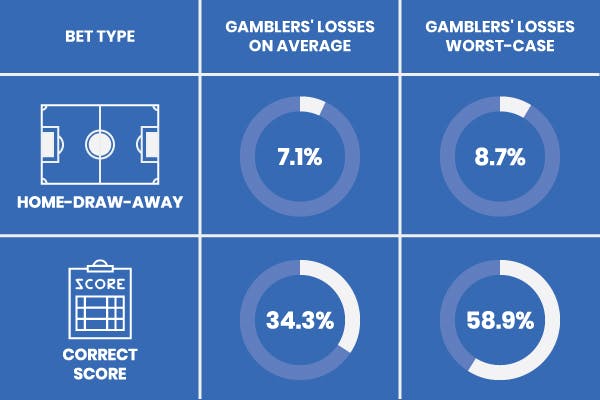By Arman Hassanniakalager and Philip Newall/The Conversation
“Please drink responsibly” is a familiar plea to those who might be inclined to consume alcohol, and we are also reminded to “gamble responsibly,” a timely reminder during a busy period for Premier League football, full of fixtures and plenty of casual fans with time on their hands.
You can make a reasonable judgement about responsible drinking by using the percentage of alcohol by volume (ABV) information on the label of whichever bottle has been opened. But how can we determine the strength of a football bet?
In fact, “gambling harm” can also be approximated by a percentage. The “gamblers’ losses” percentage is a measure of the money bet that a gambler will lose in the long term. Short term randomness around this percentage is what makes gambling interesting, but over longer time periods, gamblers will lose this percentage of all the money they bet.
We think most people probably have no idea of what percentage of money is lost across different football bets. So we looked at eight seasons of Premier League betting odds and results using machine learning.
Machine learning allowed us to simulate three potential human betting strategies over long periods of time. One “random” strategy effectively simulated the risks of throwing darts at a set of betting odds. By comparison, a “most-skilled” strategy carefully studied the betting odds and results for three whole seasons before judiciously selecting the best bet it could find for each match.
We also looked at the returns of a strategy that deliberately tried to be as unskilled as possible. The “least-skilled” strategy chose what might be thought of as the worst case scenario for each match. This mirrors the returns of someone who is not merely unlucky, but is unskilled (and who may benefit from more help and advice). Any differences between these three strategies reflect the role of skill in Premier League football betting.
The risks varied based on both the type of bet chosen and the specific betting strategy used. When simulating the returns of a given bet of, say £1, we found that the gamblers’ losses percentage varied by a factor of 54. Using the drinking comparison, this is like the difference between a 1% reduced strength lager and a strong bottle of whiskey.
Some of the highest risks came from betting on the correct score – a bet with pretty high odds – which you might have seen the actor Ray Winstone offering on British television over Christmas. For example, Manchester City to win 3-1 might have odds of 9/1, meaning every £1 bet wins £9 if Manchester City win by that score line.
We found that just randomly selecting correct score bets would hit you with a strong average loss of 34.3%. But the worse case scenario was a whopping average loss of 58.9%, which came when the least skilled strategy picked very high correct scores (such as the away team winning by four goals to nil). Of course, sometimes bets at high odds pay off. But overall, these figures mean that for every £100 bet, on average the gambler lost £34.30 and £58.90 for their betting strategies.
Luckily there are two tips that gamblers can do to keep their losses within reasonable limits.
Good Odds It’s Bad Bet
The first tip is to select types of bets with relatively low odds. The bookmakers love advertising correct score bets, for example, because these bets offer high odds if gamblers guess the correct score.
But one bet with lower odds is what we call a “home-draw-away” bet, either betting on Manchester City to win, draw, or lose to the away team. Here the random strategy returned average percentage losses of 8.7%, so nearly four times less than randomly choosing correct score bets.
The second tip is to select bets with relatively low odds within a given bet type. Manchester City are usually expected to win by the bookmakers, and at the time of writing, betting £1 on them to win their recent match against Southampton gave a potential win of £1.27 if successful. By comparison, a £1 bet on Southampton to triumph would return £11 if successful.
Many gamblers might get excited by those higher odds on Southampton winning. But across each bet type, bets at low odds had the lowest average losses for gamblers. If a bet has odds that seem too high to be true, it probably is a bad bet on average.

The gambling industry recently announced that it will stop showing gambling advertising pre-watershed starting next summer. So promoting betting odds on TV during the football will soon become a thing of the past.
But the industry is currently spending five times as much on online marketing (£1.2 billion) as on its total TV advertising spend. This online marketing is largely hidden to anyone who is not targeted to receive these messages.
We believe that the very high differences in product risk across football bets should at least be communicated in some way to consumers. While further research should investigate how best to educate football fans about these different risks, reminders to just “gamble responsibly” won’t cut it.
Consumers need to be told about the risks of football bets with high odds.
Arman Hassanniakalager is a lecturer in finance at the University of Bath. Philip Newall is a postdoctoral fellow at the University of Warwick. This article is republished from The Conversation under a Creative Commons license.
–
Comments welcome.
Posted on January 8, 2019


